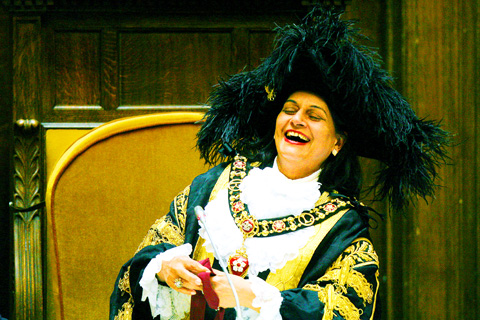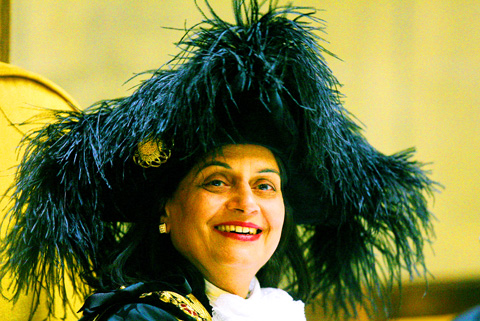Manjula Sood made history this week when she slipped the gilded robes and chain of office over her sari and became lord mayor of the British city of Leicester.
A south Asian woman has never held the largely ceremonial post in the 799 years since it was created in the city nor in the 1,000 years or so that it has been in existence elsewhere in Britain.
It is a first not just for Sood, 12 years after following her late husband, Paul, into local politics, and just over 38 years after she arrived in the English East Midlands from the Punjab on a cold, dark snowy winter’s day.

PHOTO: AFP
It is also the latest sign of the transformation of Leicester, famous for its textile, footwear and hosiery industry, as it moves towards becoming the UK’s first non-white majority city in the not too distant future.
“To be the first is a great honor for me,” the Indian-born former primary schoolteacher said of the 12-month post, which began on Thursday.
“It’s made me very proud of myself that I’m going to represent my city ... . I wasn’t expecting it.”

PHOTO: AFP
The appointment to lead Leicester’s 288,000 or so citizens, 25 percent of whom are of Indian origin, puts Sood among the UK’s establishment, although she has held the ancient post of High Bailiff of Leicester for the past year.
On a wider scale, it also says much about the positive aspects of immigration that are often overlooked here by the debate over the extent to which new arrivals benefit the UK and affect its culture and identity.
At a glance, Sood seems the embodiment of the successfully integrated immigrant championed by modern-day politicians, many of whom she says have been fed at her kitchen table and passed through while campaigning locally.
It is not just the immaculate black sari set off by the shiny Blackberry personal organizer, the comfortable semi-detached house in a residential suburb or the fact that she has taken UK citizenship and speaks fluent English.
There are photographs of her two grownup sons, in gowns and mortar boards, proudly clutching degree scrolls from British universities: one is also a municipal councilor in Leicester; the other works for an investment bank.
A framed woman of achievement and a national merit award from the governing Labour Party are hung on another wall.
On a corner table by the coal-effect gas fire is a photograph of Hindu guru Sathya Sai Baba next to medieval-style Christian religious icons and rosary beads.
An Anglican canon is a close friend; she sits on the Leicester Council of Faiths and social, health and women’s groups; two African Caribbean men have the keys to her house to do odd jobs, she says.
Sood says she feels a duty over the next 12 months to uphold Leicester’s largely harmonious diversity at a time when critics of multi-culturalism warn of no-go areas for non-whites and communities living parallel lives elsewhere.
“I’m going to be the lord mayor not for one faith but for the city of Leicester,” she said.
One of her spiritual advisers will be Christian. The other will be Hindu. The civic service to mark her appointment will also be held in the city’s Anglican cathedral rather than a Hindu temple.
“Leicester’s a British city,” she says. “I’m representing Leicester as first citizen. The religion of this country is Church of England.”
Sood, though, recognizes that her story is not typical of the vast majority of immigrants that came to the UK and that she was fortunate.
She spoke the language, held a master’s degree in sociology and came from a well-off family: her father was a doctor in New Delhi, her mother a teacher.
An assertive nature helped when she went into teaching after being told to settle for factory work like many newly arrived Indian women — or stay at home in often substandard accommodation.
But she said she still faced the same challenges of casual racism, ignorance and prejudice as the thousands of other Indians, Pakistanis, Bangladeshis, and Kenyans and Ugandans of South Asian ancestry who made their way to Leicester in the 1970s.
As the only Indian teacher among white faces she said she pushed to promote tolerance and understanding between often bewildered newly arrived children of different faiths and cultures and their local classmates. The UK is now a more tolerant place than the one she knew in 1970, she says, with people more respectful of diversity of culture and faith.
But work is still required as a new wave of immigrants, many of them from Eastern Europe, arrive in increasing numbers — and “outreach” is the aim of her term of office as lord mayor.
“The communities that came here in the 60s and 70s now feel an integrated part of British society. Now there are new communities finding the same problems,” she said.
“History is being repeated. The same challenges are facing them. There’s always some sort of hostility from the host community. It’s a human instinct but if we don’t work at it and don’t kill it, it will escalate.”

The canonical shot of an East Asian city is a night skyline studded with towering apartment and office buildings, bright with neon and plastic signage, a landscape of energy and modernity. Another classic image is the same city seen from above, in which identical apartment towers march across the city, spilling out over nearby geography, like stylized soldiers colonizing new territory in a board game. Densely populated dynamic conurbations of money, technological innovation and convenience, it is hard to see the cities of East Asia as what they truly are: necropolises. Why is this? The East Asian development model, with

June 16 to June 22 The following flyer appeared on the streets of Hsinchu on June 12, 1895: “Taipei has already fallen to the Japanese barbarians, who have brought great misery to our land and people. We heard that the Japanese occupiers will tax our gardens, our houses, our bodies, and even our chickens, dogs, cows and pigs. They wear their hair wild, carve their teeth, tattoo their foreheads, wear strange clothes and speak a strange language. How can we be ruled by such people?” Posted by civilian militia leader Wu Tang-hsing (吳湯興), it was a call to arms to retake

This is a deeply unsettling period in Taiwan. Uncertainties are everywhere while everyone waits for a small army of other shoes to drop on nearly every front. During challenging times, interesting political changes can happen, yet all three major political parties are beset with scandals, strife and self-inflicted wounds. As the ruling party, the Democratic Progressive Party (DPP) is held accountable for not only the challenges to the party, but also the nation. Taiwan is geopolitically and economically under threat. Domestically, the administration is under siege by the opposition-controlled legislature and growing discontent with what opponents characterize as arrogant, autocratic

When Lisa, 20, laces into her ultra-high heels for her shift at a strip club in Ukraine’s Kharkiv, she knows that aside from dancing, she will have to comfort traumatized soldiers. Since Russia’s 2022 invasion, exhausted troops are the main clientele of the Flash Dancers club in the center of the northeastern city, just 20 kilometers from Russian forces. For some customers, it provides an “escape” from the war, said Valerya Zavatska — a 25-year-old law graduate who runs the club with her mother, an ex-dancer. But many are not there just for the show. They “want to talk about what hurts,” she